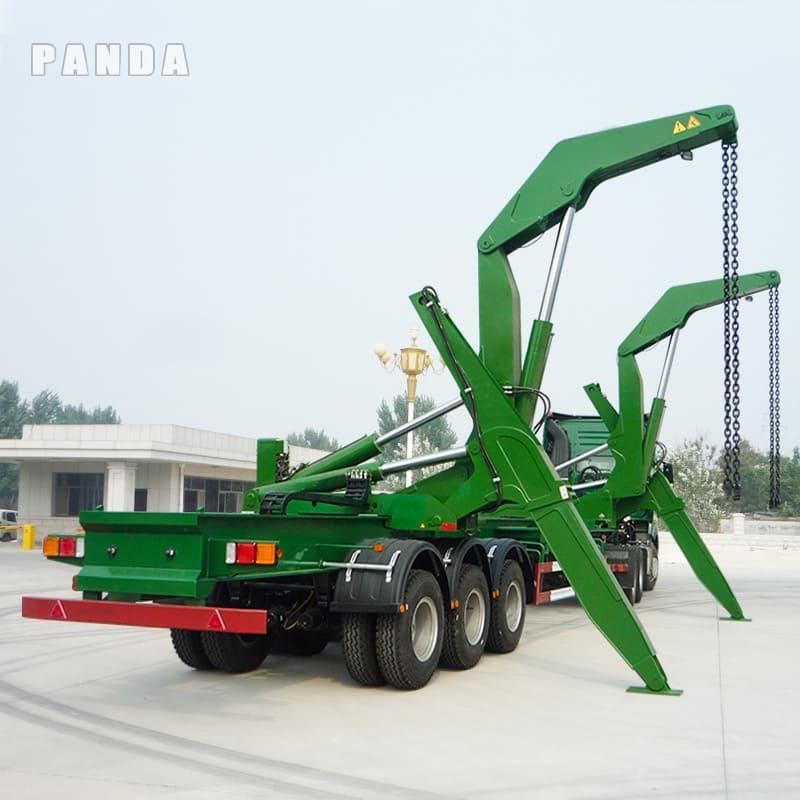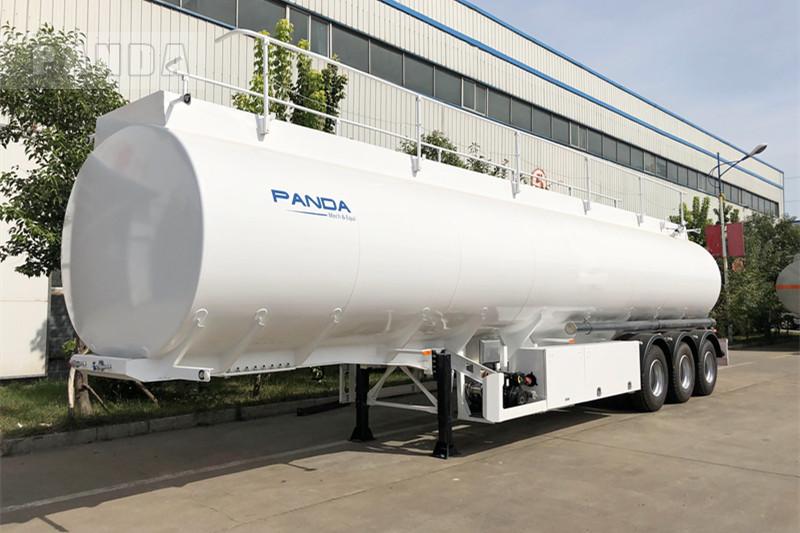Вы когда-нибудь задумывались, как работают цементовозы, позволяющие безопасно перевозить тонны сухого цемента? Это все благодаря сжатому воздуху! 🚛💨 Эти прицепы используют давление воздуха, чтобы легко загружать и разгружать цемент. Самое интересное, что воздух делает цемент похожим на жидкость, поэтому он течет плавно. Системы, работающие на воздухе, также могут поднимать цемент очень высоко, что помогает при погрузке и разгрузке. Такая продуманная конструкция позволяет сохранить цемент сухим и чистым во время транспортировки. Вот почему цементовозы так хорошо работают!

Как работают цементовозы во время погрузки
Погрузка цементного прицепа очень проста: поместите пневматический прицеп под загрузочное отверстие и задействуйте машину для загрузки цемента.
Видео погрузки цементного прицепа
Загрузочные отверстия и механизмы уплотнения
Как цемент попадает в цистерну? Все начинается с загрузочных отверстий. Это отверстия в верхней части резервуара, куда заливается цемент. Каждый порт имеет герметичное уплотнение, обеспечивающее сохранность цемента.
Почему герметизация так важна?
- Он препятствует проникновению влаги. Цемент и вода не смешиваются!
- Он сохраняет цемент чистым для использования в строительстве.
- Он предотвращает протечки, поэтому цемент не расходуется зря.
Уплотнения рассчитаны на изменение давления внутри цистерны. Благодаря этому цемент остается в отличной форме даже при длительных поездках.
Как работает цементовоз при разгрузке
Разгрузка пневматический прицеп может показаться сложной, но она тщательно спланирована. Давайте разберем все по шагам.

Процесс нагнетания и сброса давления
Как давление воздуха помогает разгружать цемент? Все просто! Сжатый воздух создает давление внутри резервуара. Это давление выталкивает цемент по трубам. Представьте, что вы вдуваете воздух через соломинку, чтобы переместить воду - это та же идея, только больше.
Предустановленное затрубное давление также помогает герметизировать систему и остановить образование каналов. Это делает разгрузку более плавной и быстрой.
Разгрузочные клапаны и трубы
Разгрузочные клапаны и трубы - ключевой момент при разгрузке. Как они работают? Воздушный компрессор делает цемент похожим на жидкость, помогая ему легко течь по трубам. Когда давление в резервуаре достигает 0,2 МПа, цемент начинает выходить наружу.
Клапаны контролируют количество выходящего цемента. Они открываются и закрываются, чтобы регулировать поток. Трубы выдерживают высокое давление и направляют цемент без утечек. Эта система уменьшает количество остатков цемента, экономит время и сокращает количество отходов. Это как кран для цемента!
Предотвращение заторов при разгрузке
Засоры могут замедлить работу, но их можно предотвратить. Как их остановить? Следуйте этим советам:
- 🧴 Используйте специальные химические средства, чтобы предотвратить прилипание цемента к поверхностям.
- 🚪 Держите крышки люков закрытыми, чтобы не допустить попадания влаги во время погрузки.
- 🌬️ Используйте закрытые системы для уменьшения количества пыли и предотвращения засоров.
- 🧹 Очищайте поверхности после загрузки, чтобы предотвратить затвердевание цемента.
- 🌧️ Избегайте разгрузки в плохую погоду, чтобы снизить риски.
- 🧽 Очищайте цементную пыль после разгрузки, чтобы предотвратить будущие засоры.
Эти шаги позволяют сохранить пневматический прицеп бесперебойную работу и избежать задержек.
Совет профессионала: Всегда проверяйте систему разгрузки перед началом работы. Быстрый осмотр может сэкономить вам время!
Основные части цистерны для цемента
Цистерны для цемента состоят из множества деталей, которые работают вместе. Каждая из них важна для бесперебойной и легкой работы. Давайте рассмотрим основные части, из которых состоят эти цистерны пневматические прицепы так полезно.
Дизайн корпуса резервуара
Корпус цистерны - самая важная часть цементовоза. Почему это важно? Он сохраняет цемент в целости, сухости и чистоте во время транспортировки. Бак изготовлен из прочной углеродистой стали (Q345B) толщиной 5,0 мм. Это делает его достаточно прочным, чтобы выдерживать ежедневное использование и давление.
Система воздушных компрессоров
Воздушный компрессор - это двигатель пневматический прицеп. Он создает давление воздуха, необходимое для перемещения цемента. В большинстве цементовозов используется Двухцилиндровый ротационный компрессор 12/2 на дизельном топливе. Он маленький, легкий и очень надежный.
Вот почему воздушный компрессор так хорошо работает:
- В нем есть хорошее сопротивление сжатиюПри этом поток воздуха остается постоянным.
- Сайт большой угол псевдоожижения помогает разгружать цемент быстрее и с меньшим количеством отходов.
- Система смазки обеспечивает его бесперебойную работу в течение длительного времени.
Ознакомьтесь с характеристиками воздушной компрессорной установки:
| Характеристика | Описание |
|---|---|
| Воздушный компрессор | Двойной цилиндр 12/2 |
| Дизайн | Маленький, легкий, безопасный и надежный |
| Структура резервуара | Хорошо выдерживает давление, быстро разгружается |
| Источник питания | Дизельное топливо |
| Способ смазки | Смазка |
Без этой системы перемещение цемента в цистерне было бы очень сложным.
Псевдоожиженный слой и разгрузочные трубы
Теперь поговорим о псевдоожиженном слое и разгрузочных трубах. Эти детали работают вместе, чтобы помочь цементу плавно течь при разгрузке. В псевдоожиженном слое используется давление воздуха, чтобы цемент вел себя как жидкость. Это предотвращает образование комков и засоров.

Вот почему они так хорошо работают:
- Сайт скорость рециркуляции твердого тела сбалансирован, чтобы поток был плавным.
- Сайт чувствительность к перепаду давления обеспечивает идеальную скорость воздуха для разгрузки.
- Конструкция позволяет уменьшить количество остатков цемента, что экономит время и сокращает количество отходов.
Вот краткий обзор их производительности:
| Описание доказательств | Ключевой момент |
|---|---|
| Регулирование скорости рециркуляции твердого тела | Поддерживает равновесие между скоростью выгрузки и подъема |
| Чувствительность к перепаду давления | Обеспечивает беспрепятственный поток в нагнетательных трубах |
| Пропускная способность по насыщению | Предотвращает перегрузку при низких скоростях воздуха |
| Коэффициент разгрузки твердых тел | Улучшает поток с помощью псевдоожиженных частиц |
Благодаря этим особенностям разгрузка цемента из прицепов для сыпучих грузов не вызывает затруднений даже в сложных условиях.
Функции безопасности и аварийные системы
Безопасность очень важна для прицепов-цистерн с цементом. Эти прицепы перевозят тяжелые грузы и используют системы давления воздуха. Поэтому для их безопасной работы необходимы надежные средства защиты. Давайте рассмотрим основные системы, которые обеспечивают их безопасность. 🚦
Встроенные клапаны сброса давления 💨
Клапаны сброса давления очень важны для безопасности. Они поддерживают давление в резервуаре на безопасном уровне. Если давление становится слишком высоким, эти клапаны автоматически сбрасывают его. Это защищает резервуар и поддерживает его работоспособность.
Почему они великолепны:
- Они работают сами по себе, поэтому постоянный контроль не требуется.
- Они предотвращают повреждение резервуара под действием высокого давления.
- Они обеспечивают дополнительную безопасность при разгрузке.
Сигналы и индикаторы безопасности 🔔
Сигналы и индикаторы безопасности похожи на предупреждающие сигналы. Они сообщают оператору, что что-то не так, например, низкое давление воздуха или засорение трубы. Эти сигналы помогают устранить проблемы до того, как они усугубятся.
Почему они важны:
- Они информируют оператора о состоянии прицепа.
- Они помогают предотвратить несчастные случаи, выявляя проблемы на ранней стадии.
- Они позволяют быстрее и проще устранять неполадки.
Наконечник: Всегда проверяйте эти системы перед использованием прицепа. Быстрая проверка может избавить вас от больших проблем в дальнейшем!
Благодаря этим элементам безопасности прицепы-цистерны для цемента справляются с тяжелыми работами, обеспечивая безопасность каждого. Это как невидимые помощники, которые держат все под контролем!
Техническое обслуживание цементовоза
Поддерживать цементовозы в отличной форме - это не только избегать поломок, но и обеспечивать их эффективную работу в течение многих лет. Позвольте мне рассказать вам о ключевых шагах, которые помогут вам обслуживать цистерну как профессионал.
Регулярные осмотры и проверка износа
Почему инспекции так важны? Они помогают выявить мелкие проблемы до того, как они превратятся в крупные. Я всегда рекомендую регулярно проверять ваш автоцистерну, особенно после длительных поездок или на пересеченной местности. Вот что я узнал о пользе регулярных проверок:
- Они улучшают общее состояние оборудования и продлевают срок его службы.
- Частые проверки могут продлить срок службы прицепа на годы, даже если он используется на сложных дорогах.
- Профилактическое обслуживание сокращает время незапланированных простоев, а значит, уменьшает количество задержек и повышает производительность.
- Проверки безопасности позволяют выявить потенциальные проблемы на ранней стадии, обеспечивая безопасность и соответствие требованиям.
Совет профессионала: Составьте контрольный список для проверок. Осмотрите корпус резервуара, клапаны, трубы и воздушный компрессор. Это небольшое усилие, которое окупается с лихвой!
Очистка резервуара и удаление остатков цемента
Остатки цемента могут вызвать самые разные проблемы, от засорения до дополнительного износа бака. Как избежать этого? Регулярно чистите бак! Поверьте, это стоит усилий. Исследования показывают, что хорошая очистка может:
- Продлевает срок службы резервуара и его поверхностей.
- Сокращение расходов на ремонт до 40%.
- Сократите потребность в структурном ремонте с течением времени.
Для удаления остатков цемента я предпочитаю использовать специализированные инструменты для очистки. Также полезно очистить резервуар сразу после разгрузки. Это предотвратит застывание цемента и облегчит следующую работу.
Быстрый совет: Во время уборки всегда проверяйте наличие влаги. Цемент и вода плохо смешиваются, поэтому держите резервуар сухим, чтобы избежать образования комков.
Обслуживание воздушного компрессора и замена фильтров
Воздушный компрессор - это сердце вашей автоцистерны. Если он работает плохо, все замедляется. Как вы поддерживаете его в отличной форме? Регулярное обслуживание - ключевой момент. Вот на что я обращаю особое внимание:
- Следите за чистотой воздухозаборников и часто заменяйте фильтры. Это предотвратит влияние грязи и загрязнений на качество воздуха.
- Проверяйте расходные детали, такие как масляные фильтры и смазочные материалы. Их своевременная замена обеспечивает бесперебойную работу компрессора.
- Профилактическое обслуживание помогает выявить мелкие неполадки до того, как они превратятся в дорогостоящий ремонт. Кроме того, оно продлевает срок службы компрессора.
Совет профессионала: Планируйте замену фильтров и масла в соответствии с рекомендациями производителя. Немного планирования - и все получится!
Уход за цистерной для цемента не должен быть сложным. Регулярные осмотры, правильная очистка и своевременное обслуживание позволят вам поддерживать его в рабочем состоянии. Кроме того, вы сэкономите деньги и избежите головной боли в будущем. 🚛✨
Меры безопасности при эксплуатации цистерны для цемента
Обеспечение безопасности при использовании цементовоза означает готовность и осторожность. Вот простые советы по безопасности при погрузке, разгрузке и транспортировке цемента. Эти шаги помогут избежать проблем!
Безопасность при погрузке
Как безопасно погрузить цемент? Нужно проверить оборудование и территорию. Следуйте этим советам:
- 🛑 Проверьте уплотнения и порты: Перед началом работы осмотрите загрузочные отверстия и уплотнения. Плотные уплотнения предотвращают утечки и не пропускают влагу.
- 🌬️ Проверьте давление воздуха: Убедитесь, что воздушный компрессор работает исправно. Это предотвратит резкие перепады давления, которые могут повредить баллон.
- 🧰 Носите защитное снаряжение: Цементная пыль может повредить кожу и легкие. Надевайте перчатки, очки и маску, чтобы оставаться в безопасности.
- 🚪 Очистите территорию: Не подпускайте людей к погрузочным портам. Это снижает вероятность несчастных случаев, если что-то пойдет не так.
Быстрый совет: Цементная пыль может стать причиной травм. В 2020 году многие строители сообщили о проблемах, вызванных воздействием бетона. Всегда используйте защитное снаряжение!
Безопасность при разгрузке
Разгрузка цемента сопряжена с риском, но вы можете сделать ее более безопасной. Что вы должны делать? Попробуйте выполнить следующие действия:
- 💨 Управление давлением воздуха: Используйте правильное давление, около 0,2 МПа. Слишком большое давление может повредить бак, а слишком малое - привести к засорам.
- 🔧 Проверьте клапаны и трубы: Перед разгрузкой проверьте, нет ли повреждений. Сломанные детали могут стать причиной утечки или разлива.
- 🧹 Остановить засорение: Часто очищайте резервуар и используйте химические средства для предотвращения засоров. Это позволит цементу легко вытекать.
- 🚨 Используйте системы аварийного отключения: Эти системы быстро останавливают разгрузку при возникновении проблем. Они очень полезны в чрезвычайных ситуациях.
Совет профессионала: Следите за манометрами во время разгрузки. Устраняйте мелкие неполадки на ранней стадии, чтобы избежать больших проблем.
Безопасность при транспортировке
Вождение цементовоза на дальние расстояния требует особой осторожности. На чем вам следует сосредоточиться? Используйте этот контрольный список:
- 🚛 Выберите правильный трейлер: Используйте прицеп, который подходит для перевозки цемента. Это поможет сохранить его устойчивость и безопасность.
- 🛠️ Проверьте инструменты безопасности: Осмотрите запорные клапаны, огнетушители и системы сброса давления. Убедитесь, что они хорошо работают.
- 📜 Следуйте правилам: Соблюдайте требования DOT и другие правила безопасности. Это позволит избежать штрафов и сохранить законность.
- 🧑🏫 Водители поездов: Обучите водителей действиям в чрезвычайных ситуациях. Ежегодное обучение важно для безопасности.
- 🔄 Проводите регулярное техническое обслуживание: Ежемесячно очищайте цистерну, проверяйте компрессор и заменяйте фильтры. Это позволит сохранить работоспособность автоцистерны.
Знаете ли вы? Системы ESC могут предотвратить опрокидывание, автоматически задействуя тормоза. Они делают вождение более безопасным!
Соблюдение этих правил позволит вам сохранить безопасность и доставить цемент в отличном состоянии. Безопасность всегда на первом месте! 🚦
Прицепы-цистерны для цемента очень важны для перемещения сыпучих материалов, таких как цемент. Почему они так важны? Они эффективно транспортируют материалы, не загрязняя их и сохраняя в хорошем состоянии. Благодаря использованию современных пневматических систем эти прицепы делают погрузку и разгрузку более быстрой и безопасной. Это экономит время и трудозатраты.
Уход за этими автоцистернами необходим для поддержания их в рабочем состоянии. Регулярные проверки, чистка и обслуживание таких деталей, как воздушный компрессор и гидравлическая система, помогут избежать дорогостоящего ремонта. Например, работа смесительного барабана на максимальной скорости 14 об/мин и ежегодный осмотр гидравлической системы помогут автоцистерне прослужить дольше. Вот как техническое обслуживание повышает производительность:
| Компонент | Практика технического обслуживания | Влияние на производительность |
|---|---|---|
| Смесительный барабан | Не превышайте скорость 14 об/мин; ежегодно проверяйте подшипники. | Предотвращает ранний износ и продлевает срок службы барабана и лезвий. |
| Гидравлическая система | Часто проверяйте масло и давление; в холодную погоду предварительно прогревайте. | Поддерживает работоспособность системы и предотвращает сбои. |
| Система водоснабжения | Слейте воду зимой, чтобы предотвратить замерзание; соблюдайте правила безопасности. | Обеспечивает безопасную и эффективную работу системы водоснабжения. |
| Общее использование | Не перегружайте машину и не делайте резких поворотов; включайте пониженную передачу. | Помогает прицепу служить дольше и предотвращает повреждения. |
Новые технологии в пневматических прицепах сделали их более энергоэффективными и дешевыми в обслуживании. Эти обновления делают прицепы-цементовозы более гибкими и более безопасными для окружающей среды. Герметичная конструкция также сохраняет материалы чистыми, обеспечивая высочайшее качество бетонной продукции.
Наконечник: Соблюдение правил безопасности и регулярное техническое обслуживание не только продлит срок службы вашей автоцистерны, но и улучшит ее работу. Это очень важно для безопасности и производительности! 🚛✨
Вопросы и ответы
Каков принцип работы прицепа-цистерны для цемента?
Для перемещения цемента используется сжатый воздух. Давление воздуха помогает цементу течь, как вода. Это делает погрузку и разгрузку быстрой и легкой. Кроме того, конструкция позволяет сохранить цемент сухим и чистым.
Как предотвратить засорение при разгрузке?
Очистите резервуар и используйте химические средства против налипания. Регулярная очистка предотвращает налипание и затвердевание цемента. Химические средства помогают предотвратить засоры, а поддержание системы в сухом состоянии позволяет избежать проблем с влажностью.
Можно ли перевозить другие материалы в цистерне для цемента?
Да, но только сухие порошки. Цементовозы лучше всего подходят для таких материалов, как зола или известь. Избегайте жидкостей или влажных материалов, так как они могут повредить систему.
Как часто следует обслуживать воздушный компрессор?
Проверяйте его ежемесячно и заменяйте фильтры по мере необходимости. Регулярный уход позволяет поддерживать компрессор в рабочем состоянии. Следуйте рекомендациям производителя по замене и проверке масла.



